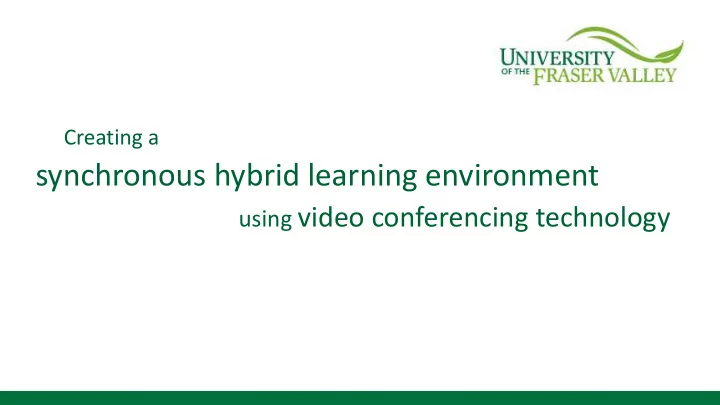

Creating a synchronous hybrid learning environment using video conferencing technology
First, a definition of “synchronous hybrid learning environment” F2F learning and online learning implemented in a concurrent way, where a lesson is delivered to both classroom and online students simultaneously. Wang, Q., Quek, C., & Hu, X. (2017)
A brief history • Started in 2015 • Initiated by the Adult Education Department • Modest initial design and training • New room designed by Education Technologist • Faculty trained and supported by Ed Techs • From 2 or 3 classes to now 15 per semester
The opportunities (the Why?) • Mixed preference - (online and on campus) • Demand for online courses are growing – Accessibility (i.e. remote location, physical barriers, etc.) – limited classroom availability • Technology is advancing – low cost and easy to use – Technology makes this mode of delivery possible
The research says “Results showed that the Blended Synchronous Learning “Results showed that the Blended Synchronous Learning Environment (BSLE) had the capability to support online Environment (BSLE) had the capability to support online and classroom students at the same time and provide and classroom students at the same time and provide equivalent learning experiences for them...” equivalent learning experiences for them...” Wang, Q., Quek, C., & Hu, X. (2017)
The research says “…but it had certain challenges as well.” Wang, Q., Quek, C., & Hu, X. (2017)
Attitude and perception Blended Learning (BL) has generally been viewed positively by faculty because it has Students also appear to see benefit in BL. Like created economies which enable them to faculty, they often view it as capable of freeing reduce and/or better manage their them from their weekly schedule of on-campus workload. courses without any noticeable loss in quality. However, since BL requires that students spend at least some time on campus, it cannot be successful in solving the accessibility dilemma for the typical, off- campus DE student. Solution : Bl Blended Sy Synchronous us Learning E Environments Power, T., & Morven-Gould, A. (2011)
and, a picture of a SHLE
and, our equipment
The challenges • Challenge with Technology – which technologies to use? – cost and obsolescence • Challenge with Pedagogy – Instructors’ comfort level with technology (distractions) – Educational Technologists support role
Cameras camera 1 Captures students
Camera 1 (Students) camera 1 Captures students
Camera 1 (Students) camera 1 Captures students
Cameras camera 2 Captures instructor
Camera 2 (Instructor) camera 2 Captures instructor
Connecting students interface Collaborate Ultra
Connecting students student view Switch from slide to classroom view
Going beyond the technology • Questions to ask instructors: o What active learning strategies can include both audiences?
Instructor training • Hands on o Blackboard Collaborate Ultra (60 minutes) o Simulations (60 minutes) o Ongoing training (unlimited)
The future 2 screens To see online activity & instruction material
The future
The future Sensitive mics Still testing
The future Cameras 4K and auto tracking
The future (Equipment) Many options
The future Many options
Questions?
Wang, Q., Quek, C., & Hu, X. (2017). Designing and Improving a Blended Synchronous Learning • Environment: An Educational Design Research. The International Review Of Research In Open And Distributed Learning, 18 (3). doi:http://dx.doi.org/10.19173/irrodl.v18i3.3034 references Power, T., & Morven-Gould, A. (2011). Head of gold, feet of clay: The online learning paradox. The • International Review Of Research In Open And Distributed Learning, 12 (2), 19-39. doi:http://dx.doi.org/10.19173/irrodl.v12i2.916
Recommend
More recommend